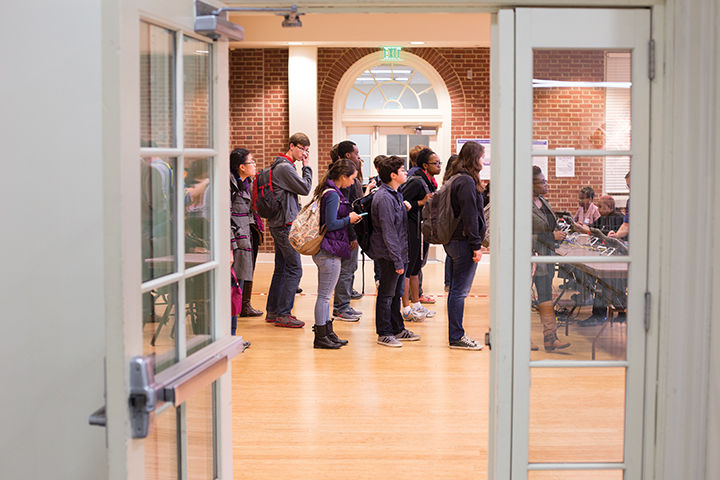The Terps Vote coalition, an SGA initiative bringing together several campus organizations, held its first tabling event Thursday in an effort to register as many University of Maryland students as possible to vote before the Maryland primary April 26.
The coalition, which started planning in November, includes the Student Government Association, MaryPIRG, the Residence Hall Association, College Democrats, College Republicans, Progressive College Republicans, Terps for Israel, the Interfraternity Council, CIVICUS and College Park Scholars.
The groups work together to encourage students to register to vote through biweekly tabling efforts during the semester and community outreach at other events on the campus. Several coalition members helped students register while they waited in line for Sunday’s basketball game against Michigan State.
The coalition also worked to register students before the 2008 and 2012 elections.
“As millennials and college students, we believe in a lot of things, but we can’t have our voices heard unless we get our students out and voting in the polls,” said Andrea Holtermann, director of Terps Vote and a junior government and politics major.
According to the U.S. Census Bureau, the bracket of eligible voters younger than 24 years old has seen the smallest proportion of voters making it to the polls in every presidential election since the bureau began collecting data about voting and registration in 1964.
The largest percentage of this age group that voted was 50.9 percent in 1964, although voting data was less reliable during this time because the bureau did not account for citizenship status. In the 2012 election, 38 percent of millennials, people born between 1982 and 2000, voted. In other age brackets, more than 50 percent of the eligible population voted fairly consistently.
This trend continues despite the growing number of voting-age millennials. Millennials have outnumbered living baby boomers to become the largest U.S. voting age group, according to a 2015 U.S. Census Bureau report.
“We’ve surpassed baby boomers, and that gives us the potential to have a major influence on the political landscape of this country,” Holtermann said.
Yet millennials’ prominence is not reflected in the primaries so far.
Only 10 percent of voters in the South Carolina Republican primary — in which 17-year-olds are eligible to vote — were between 17 and 29 years old, according to a CNN exit poll. In the Nevada caucus, 18 percent of Democratic primary voters were between 17 and 29.
Tom Klotz, MaryPIRG’s chapter president and a senior government and politics major, said this lack of turnout doesn’t necessarily indicate young people don’t care.
“I think that there is a myth that’s propagated through our society that young people are apathetic,” Klotz said. “Apathy doesn’t exist among young people.”
This is the last presidential election in which not all millennials will be old enough to cast a vote, and the last in which millennials represent the youngest eligible voters, a fact Terps Vote coalition members said is a special opportunity to get more students involved.
In her first experience voting in the 2014 midterm elections, Holtermann said, she did some basic research but found herself facing a lot more than gubernatorial candidates in the booth.
“That was something that sort of struck me,” she said. “I was just not prepared for it, and I was not able to make an informed decision.”
The coalition plans to hold events throughout the semester to encourage students not only to register but also to be informed before voting, Holtermann said.
Olivia Delaplaine, a freshman government and politics major, said voter registration is as important for young people as anyone else.
“Your ancestors fought for their lives so that you would be able to vote and shape America into what you want it to be,” she said. “When people don’t vote, it’s disrespectful to our history.”



